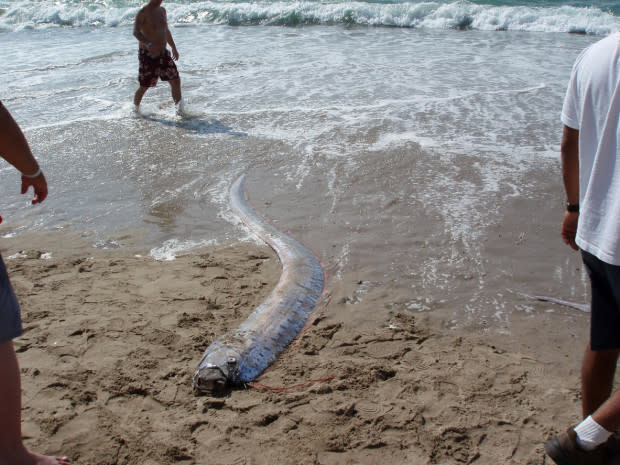‘Oarfish’ Are Now Resurfacing—and a Superstition Has Some People Worried the ‘Doomsday’ Fish Is a Serious Warning

The oarfish, a rare deep-sea creature often referred to as the "harbinger of death" or the "doomsday fish" has once again surfaced, stirring up a mix of superstitions and anxieties. Long-told legends surrounding the oarfish have persisted for centuries, with Japanese culture associating its appearance with impending doom or catastrophic events.
The sea serpent has also been nicknamed "The Messenger from the Sea God's Palace."
It's one of the longest fish species in the world, known to grow more than 30 feet in length and weigh up to 600 pounds. Its slender, ribbon-like body and iridescent silver scales are rarely spotted by humans due to its preference for depths between 656 and 3,200 feet. However, oarfish have been recently spotted by scuba divers in Taiwan. Why?
Related: Why You Shouldn't Remove a Dryer Sheet in Your Mailbox if One Mysteriously Appears
Giant rare deep-sea oarfish spotted by divers pic.twitter.com/BEYfoHddys
— Ecosapiens (@ecosapiensxyz) July 27, 2023
Legend has it, the oarfish is known to run to the surface only when many humans are about to be in danger. It's believed that the oarfish appears as a warning, to show that an earthquake or a tsunami is approaching. And there's a reason that people in the present-day take this old myth to heart.
I’m blaming all my life problems on the oarfish
— badgyalbrit🇯🇲 (@kawaii_britt) July 26, 2023
Back in 2010, at least a dozen oarfish were reported to have washed up onto Japan's coastline. Not long after, in March 2011, a severe earthquake hit Japan’s Fukushima, simultaneously triggering a deadly tsunami.
Before a deadly 2017 earthquake in the southern Philippines, six oarfish were spotted days prior. And just a couple of years later in early 2019, at least three oarfish were found washed up on Japan's shores—just months before the Yamagata earthquake and blackout.
View the original article to see embedded media.
Whether or not recent oarfish sightings lead to a deadly natural disaster remains to be seen. However, scientists urge that this old myth doesn't hold merit—for many different reasons.
Mark Benfield, an oceanographer and ecologist at Louisiana State University, told National Geographic, "Whatever the oceanographic phenomena are that push these animals on shore, they’re probably on a large enough scale to affect more than one oarfish."
Meaning, the oarfish wouldn’t be the only species sighted before an earthquake if the myth was true. And there would likely be many more oarfish that washed up each time if that was the case.
Hiroyuki Motomura, a professor of ichthyology at Kagoshima University, told the New York Post, “There is no scientific evidence of a connection, so I don’t think people need to worry. I believe these fish tend to rise to the surface when their physical condition is poor, rising on water currents, which is why they are so often dead when they are found."
A research study published in the Bulletin Southern California Academy of Sciences in 2018 additionally showed a correlation between oarfish strandings and the El Niño years.
During an El Niño year, the temperature at the surface of the water is higher than normal, and the deeper waters are cooler than normal. The prey of the oarfish follows the warmer water temperatures, leading the oarfish along.
View the original article to see embedded media.
Fingers crossed that scientists are correct and recent sightings of the infamous doomsday fish are nothing more than old folklore resurfacing. Time will tell if this myth holds any water!
View the original article to see embedded media.
